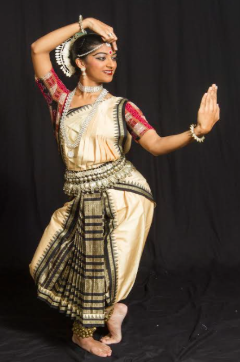Behind the Poses
We hope you all are doing well in quarantine. While it doesn’t look like we are going to go back to normal any time soon, I am happy to bring to you an informative article about two unique Odissi poses.

Darpan is a sculpturesque pose from the walls of ancient Orissa temples. Vaguely put, this pose shows a woman looking at her own reflection in a mirror (see picture on the left). With a modern peripheral lens, one might see narcissism. But if one goes a bit deeper, it all unravels. First, she looks at her beauty astonishingly. Then, she recognizes the potential inside of her. Thirdly, she takes pleasure and pride in that experience. To me, this pose is about self-love. Every time I hold this pose, a natural smile appears on my face. In the middle of dancing in front of a big crowd, I can take a deep breath during this pose, and enjoy the moment.

Odissi is characterized by various Bhangas (stances). The first example that comes to any Odissi dancer’s mind is Tribhanga, because it is one of the most common poses that act as a base for Odissi. Tribhanga means a pose in three parts. A dancer’s body has three bends in this pose: neck, waist and knee. The waist and the neck are curved oppositely looking like the shape of the English alphabet ‘S.’ The emphasis on this pose sets Odissi apart from other Indian classical dances, giving rise to movements that highlight the range of motion in the torso. This pose is often seen in traditional Indian sculptures, a common example being the deity of Lord Krishna playing the flute (see picture on the right).
– Jahnavee (Ritu) Chakravarty
